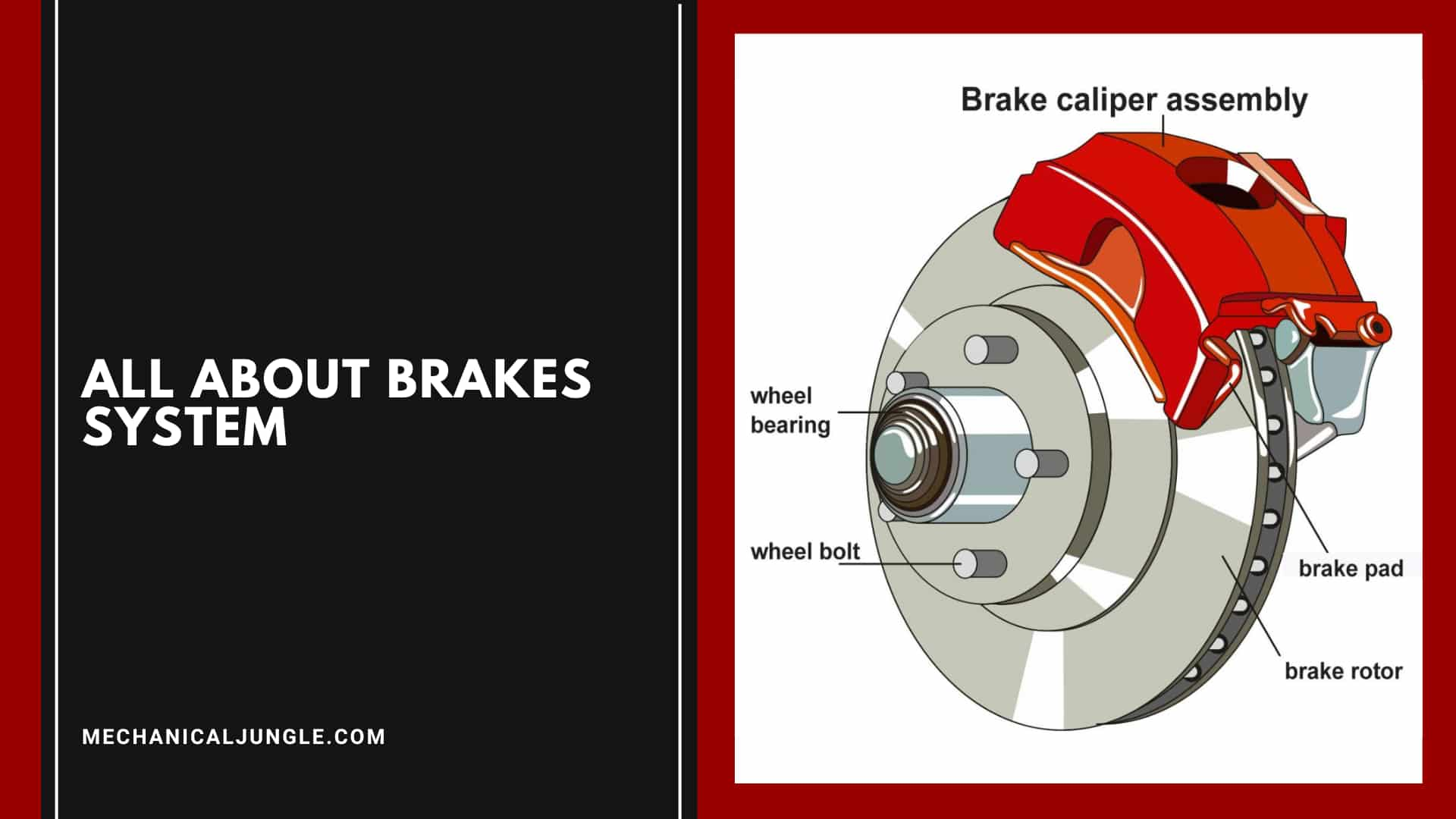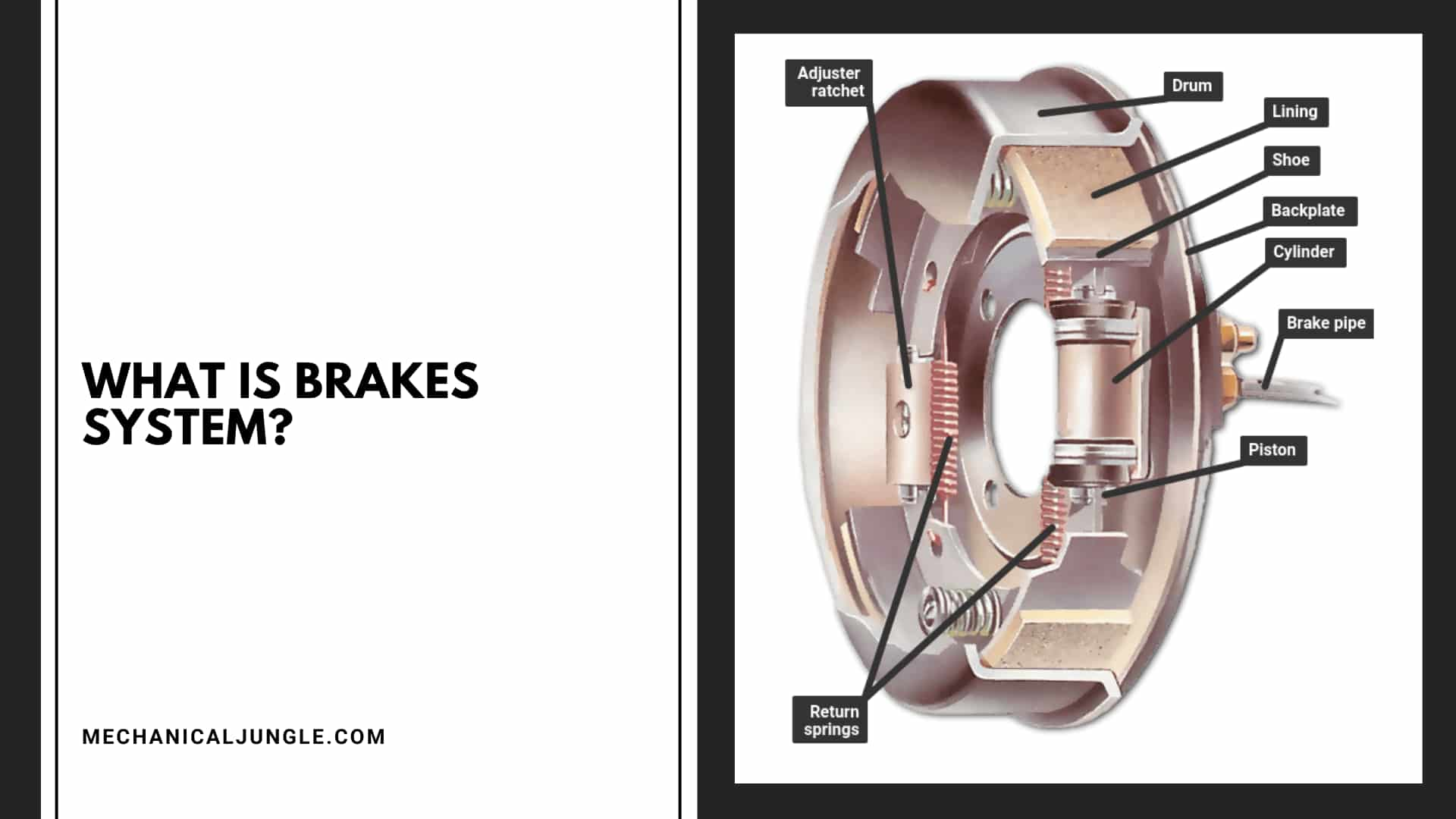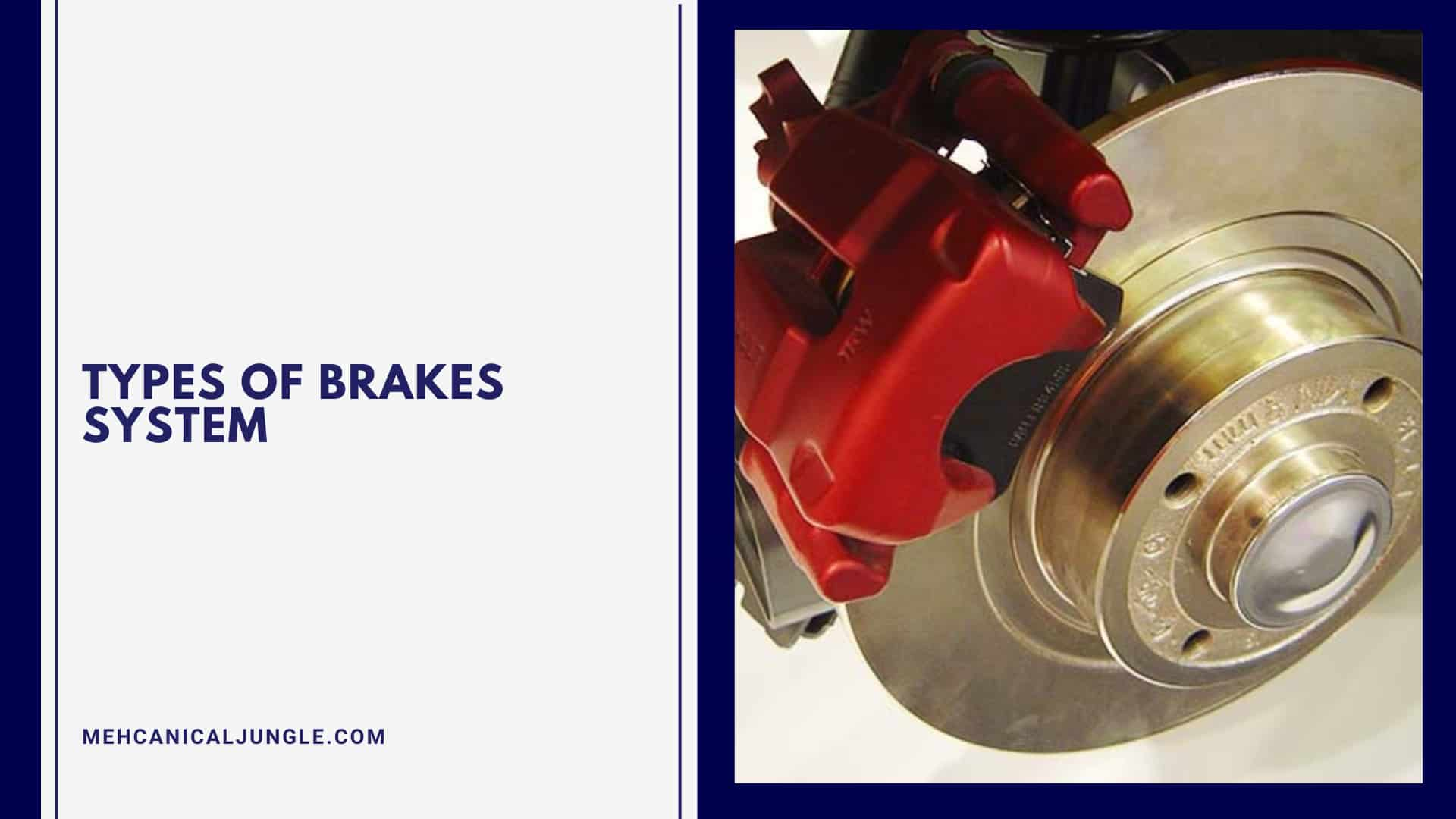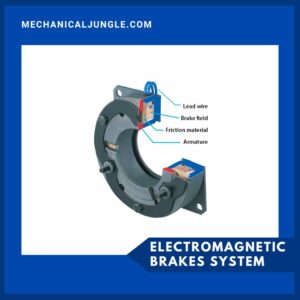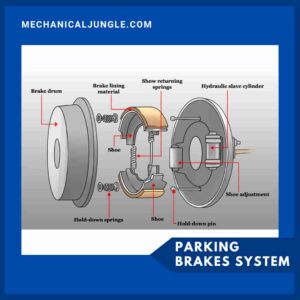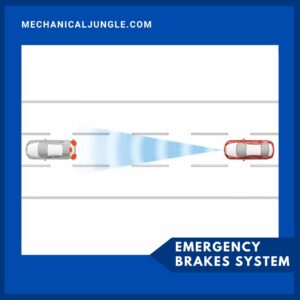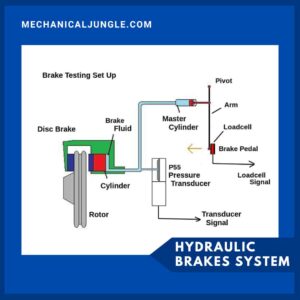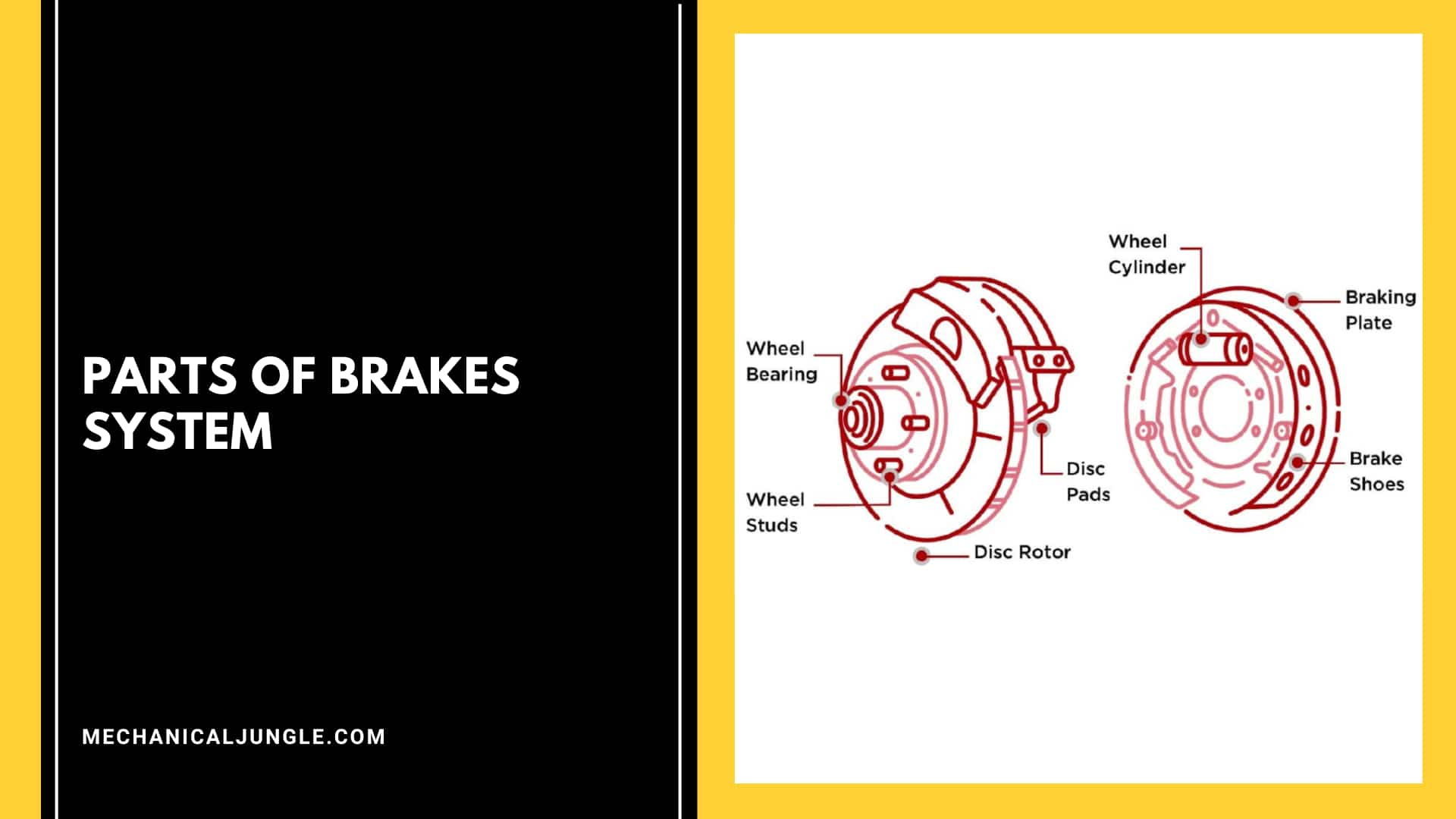Important Point
What Is Brakes System?
In automobile vehicles, a brake system is an arrangement of brake system parts or mechanical linkages of various brake system components, drum brakes or disc brakes, master cylinders or fulcrum, etc., arranged in such a way that it converts the kinetic energy of the vehicle. She gives—heat energy which in turn stops or speeds the vehicle.
Most brakes use frictions on both sides of the wheel; collective activation of the wheel converts the kinetic energy of moving objects into heat.
For example, regenerative brakes convert most of the energy into electrical energy that can be stored for later use.
Eddy currents use a magnetic field to convert kinetic energy into an electric current in a brake, brake disc, blade, or rail, which is converted into heat.
The following are the most commons types of braking systems in modern automobiles. For easy troubleshooting and maintenance, it is always good to know which one is right for your car.
A brake is an electrical and mechanical device for controlling and cutting off the motion of any rotating parts – such as a wheel or axle.
Its major feature is to determine that the maximum damping effect is called peak force.
Using friction on the two surfaces of an automobile converts kinetic energy into heat, which sometimes causes brake system failure due to excessive heat generation.
Also, Read: What Is Stub Axle? | Types of Stub Axle | What Is Front Axle? | Classification of Axle
Types of Brakes System:
1. Electromagnetic Brakes System
As the name suggests, electromagnetic brakes use the basis of electromagnetism to achieve frictionless braking, which makes them more durables in the long run.
The first choice of hybrid vehicles works without friction and smoothness compared to normal quick magnetic brakes.
The compact-sized braking system, which is also used in trains, works when a magnetic flux is passed at a location perpendicular to the rotational direction of the wheel.
This creates a fast current flow in the opposite direction of the wheel rotation, which generates energy as opposed to the rotation of the wheel, and the wheel slows down.
Electric brakes are broken into three main types:-
Anti-lock brakes system (ABS):
The system consists of three main components – individual wheel speeds sensors, hydraulic actuators, & an electricals control unit.
They work together to prevent your brakes from locking up when you bang your brakes or pump them at high speed.
Each wheel is controlled individually, which does a great job of maintaining traction.
Advanced Emergency Brakes System (AEBS):
This type of system has sensors that monitor how close the vehicle is to another vehicle or object; When this happens, an emergency brakes mechanism is activated automatically so that you do not have a collision.
Brake-By Wire Brakes System:
It is a system of electronic wiring that sends signals to the car’s computer when the brake is pressed.
It first measures the electrical resistance, and the computer calculates the applied force, applying it to the hydraulic pump system.
2. Mechanical Brakes System
Mechanical brake system powers the hand brake or emergency brake.
It is a type of brake system in which the brake force exerted on the brake pedal is carried to the finals brakes drum or disc rotor to stop the vehicle by various mechanical linkages such as cylindrical rods, fulcrums, springs, etc.
Mechanical brakes cause friction when two surfaces are rubbed together to produce a stopping action. There are two main types of mechanical brake:
Disc Brakes:
This system uses wheel brakes that slow down the rotation of the car’s wheels; The brake pads are then pushed against the rotors with a set of calipers.
Drum Brake:
The system consists of a metal brake drum that covers the brake assembly on each wheel. There are two curved brake shoes, and they move outward to stop or slow the drum, causing it to spin with the wheel.
3. Parking Brakes System
If you park your vehicles on a slope and do not want them to roll down, it is necessary to use a parking brake.
Parking brakes usually have small paddles located near the driver’s side door, below the steering column.
They can also be positioned by a lever in the console at the center. In any case, a mechanical force is necessary to properly operate the brake.
In some newer models, a simple button is sometimes used instead of a lever.
There are two different types of powers brakes, as described below.
Air Brakes:
Instead of hydraulic fluid, the air is used to activate the original drum or disc brake in this system; This type of system is often used in vehicles such as trailers, buses, and trucks.
Power Brakes Booster:
The naturally occurring vacuum power in the vehicle’s engine is used to increase the driver’s foot pressure; It will stop almost all types of vehicles, including very heavy vehicles.
4. Emergency Brakes System
The mechanisms used to control both the emergency brake and parking brake are similar. The difference is that the vehicle reacts when using each of these brakes.
Emergency brakes are used to prevent a vehicle from rolling from its location while parking the car and to prevent it from crashing when regular brakes suddenly fail.
In other words, emergency brakes are a backup measure for the rare occasion when something goes wrong with your main brake.
5. Hydraulic Brakes System
Invented in the early 1900s, the hydraulic brakes mechanism works on brake fluid, cylinder, and friction.
By internal pressure application, glycol ether or diethylene glycol forces the vehicle’s brake pads to stop the wheels from moving.
Hydraulic brakes are driven through hydraulic pressure, hence their name.
They are systems based on the principle of Pascal’s law, which states that when pressure is applied to any part of a confined incompressible fluid, it circulates equally in all directions, resulting in the same pressure variations.
Huh. There are two main types of the hydraulic brake, listed below.
Dual Circuit Hydraulic Brakes:
There are two command circuits; One activates when you apply the brakes, & the other is controlled by the car’s computer & calculates the force applied before applying it to the hydraulic pump system.
Single Circuit Hydraulic Brakes:
Systems consist of masters cylinder connected to various metal pipes and rubber fittings that are connected to the cylinders of the wheels.
Each wheel has opposing pistons on either the drum or band brakes, and when pressurized, the pistons separate. The brake pads are then forced into the wheel cylinder to stop the vehicle.
Also, Read: What Are Pliers Used? | 34 Types of Pliers
Parts of Brakes System:
Understanding the parts of a brake system is crucial for maintenance. Here are the main components of brake system in most vehicles:
1. Wheel Cylinder
Brake pads are attached to wheel cylinders which either squeeze disc brakes or separate the brake pads drum brakes when fluid flows into them.
2. Brake Pad
Brake pads actually rub against the drum or rotors. They are made of composite materials and are designed to last for many, thousands of miles.
However, if you ever hear the sound of grinding or shouting while trying to stop your car, it means that it is time for the new brake pads.
3. ABS Control Module
Found on vehicles with ABS brakes, the module performs a diagnostic check of the ABS braking system and determines when the correct pressure is to be sent to each wheel to prevent the wheels from locking.
4. Brake Pedal
Pedals are what you push with your feet to activate the brake. This causes the flow of the brake fluid through the system to pressurize the brake pads.
The driver steps on a brake pedal to activate the brakes. A piston moves in the master cylinder when the pedal is pressed.
5. Brake Booster
Reduces the amount of pressure required to apply a brake to allow any driver to operate the brake. The engine uses vacuum and pressure to increase the force applying the brake pedal on the master cylinder.
6. Disc Brakes
Among the different brake types, disc brakes, which are commonly found on the front wheels and are essential car brake system parts, have brake pads that press against the disc rotor when the brake pedals are applied to stop the vehicle. The pads are attached to a brakes caliper assembly that frames the rotor.
7. Drum Brakes
Located in the rear of the vehicles, the drum brake consists of a wheel cylinder, brake shoes, & a brake drum.
When the brake pedals are pressed, the brake shoes are pushed into the brake drum by the wheel cylinder, stopping the vehicle.
8. Emergency Brakes
The main brake operates independently of the system to protect the vehicle from rolling. Also known as the parking brake, hand brake, and e-brake, the emergency brake is primarily used to keep the vehicle in place while it is parked.
9. Master Cylinder
The master cylinder is basically plungers that are activated by the brake pedal. It is the one that holds the brake fluid and forces it through the brake lines when activated.
Converts non-hydraulic pressure to hydraulic pressure that the wheel cylinder uses to press the brake pads against the rotors to stop the vehicle.
10. Brake Lines
Typically made of steel, brake lines carry brake fluid from the master cylinder reservoir to the wheels, where the car is pressurized to stop.
Frequently Asked Questions (FAQ)
Parts of Brakes System
- Wheel Cylinder
- Brake Pad
- ABS Control Module
- Brake Pedal
- Brake Booster
- Disc Brakes
- Drum Brakes
- Emergency Brakes
- Master Cylinder
- Brake Lines
What Is Brakes?
In an automobile vehicle, braking is an arrangement of various linkages and components (brake lines or mechanical linkages, brake drum or brake disc, master cylinder or fulcrums, etc) that are arranged in such a fashion that it converts the vehicle’s kinetic energy into the heat energy which in turn stops or de accelerate the vehicle.
Brakes Types
Following are the different types of brakes:
- Disc Brakes.
- Drum Brakes.
- Emergency Brakes.
- Anti-Lock Brakes.
Like this post? Share it with your friends!
Suggested Read –
- Types of Springs
- Gear Type Pump
- Metal Cutting Fluid
- Disc Brake Components
- Hydraulic Brake System
- What Is a Stub Shaft
- How Do Drum Brakes Work
- Parts of a Nuclear Power Plant
- Domestic Electrolux Refrigerator | Different Components of Domestic Electrolux Refrigerator
- What Is Spring in Mechanical? | Types of Spring in Mechanical | Spring Materials | Application of Spring in Mechanical
- How Do Nuclear Power Plants Work? | Main Components of the Nuclear Power Plants | Working Principle of Nuclear Power Plants
- Cochran Boiler | Cochran Boiler Working | Working Principle of Cochran Boiler | Applications of Cochran Boiler | Advantages & Disadvantages of Cochran Boiler
- What Is Cupola Furnace? | Cupola Furnace Design । Cupola Construction | Purpose of Cupola | Working Principle of Cupola Furnace: | Advantages of Cupola Furnace | Disadvantages of Cupola Furnace | Applications of Cupola Furnace
